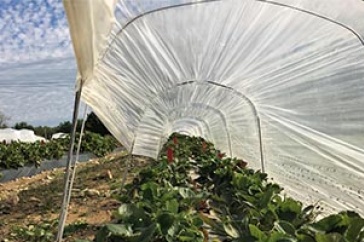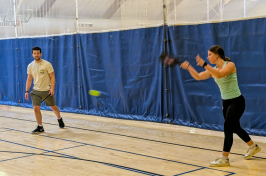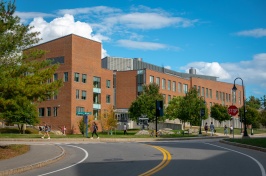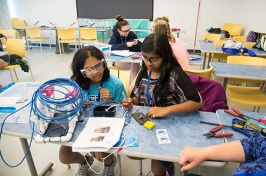UNH Research Finds N.H. Growers Can Substantially Boost Strawberry Season

Growing strawberries in low tunnels increased the percent marketable yield by about 10 percent in both years of the study and increased marketable yields during the last six weeks of the 2018 season. Photo credit: Kaitlyn Orde/UNH.
DURHAM, N.H.—Researchers at the University of New Hampshire have more than doubled the annual yield of strawberries and quadrupled the length of the New Hampshire harvest season by growing day-neutral varieties in low tunnel protective structures. The new research out of the New Hampshire Agricultural Experiment Station provides a roadmap for growers seeking to increase local production during what is normally considered the off season for locally grown strawberries.
“Our study shows that local strawberries can be grown from early summer through late fall in our area. This is yet another illustration of the diversity of crops that can be grown in this part of the country during months that were previously considered the off-season,” said Kaitlyn Orde, a research associate who worked with Becky Sideman, professor of sustainable agriculture and food systems and UNH Cooperative Extension specialist in sustainable horticulture production.
Researchers evaluated eight varieties of day-neutral strawberries that produced fruit from early-July into November in both years. Traditionally, New Hampshire’s season for locally grown strawberries is only four to six weeks in June and July. Depending on the variety, annual total yields ranged from 7,600 pounds per acre to greater than 14,000 pounds per acre. These results were obtained using a relatively low planting density; the authors estimate yields could be increased if plants were grown at slightly higher planting densities.
“Given that New England growers recently have reported average annual yields of 5,900 pounds per acre to the USDA, these are quite competitive yields for our region,” Orde said.
Critical to the success of the project was the use of day-neutral varieties of strawberries. Most New England and New Hampshire strawberry growers plant June-bearing strawberries, which are strongly affected by day-length and only initiate flower buds under short-day conditions, resulting in a brief period of fruit production each year.
“While June-bearing varieties are very productive over a short harvest season, they inherently limit availability of regionally produced strawberries during the remainder of the year, so instead, we import strawberries from elsewhere,” Orde said.
Researchers also grew the strawberries under low tunnels. They found that low tunnels increased the marketable yield by about 10 percent in both years of the study and increased marketable yields during the last six weeks of the 2018 season, from mid-September to late-October. During this six-week period in 2018, plants growing under low tunnels produced 850 pounds per acre more than plants growing on open beds (no low tunnels), which is estimated at about $3,800 in additional revenue. They also found that plants grown under low tunnels required less labor for the removal of cull fruit and runners and produced a higher percentage of marketable yield.
Additional resources are available for growers on low tunnels and day-neutral varieties.
This material is based upon work supported by the NH Agricultural Experiment Station, through joint funding of the National Institute of Food and Agriculture, U.S. Department of Agriculture, under award number 1006928, and the state of New Hampshire, and the Specialty Crops Research Initiative under award number 2014-51181-22380. Additional support was provided by UNH Cooperative Extension, New Hampshire Vegetable and Berry Growers’ Association, and the U.S. Department of Agriculture Northeast Climate Hub.
Founded in 1887, the NH Agricultural Experiment Station at the UNH College of Life Sciences and Agriculture is UNH’s original research center and an elemental component of New Hampshire's land-grant university heritage and mission.
The University of New Hampshire is a flagship research university that inspires innovation and transforms lives in our state, nation and world. More than 16,000 students from all 50 states and 71 countries engage with an award-winning faculty in top ranked programs in business, engineering, law, liberal arts and the sciences across more than 200 programs of study. UNH’s research portfolio includes partnerships with NASA, NOAA, NSF and NIH, receiving more than $100 million in competitive external funding every year to further explore and define the frontiers of land, sea and space.
PHOTO AVAILABLE FOR DOWNLOAD
https://colsa.unh.edu/nhaes/sites/default/files/media/images/tbtrial2.jpg
Photo caption: Growing strawberries in low tunnels increased the percent marketable yield by about 10 percent in both years of the study and increased marketable yields during the last six weeks of the 2018 season.
Photo credit: Kaitlyn Orde/UNH
-
Media Contact
Lori Tyler Gula, PhD | NH Agricultural Experiment Station | lori.gula@unh.edu | 603-862-1452
Latest News
-
September 15, 2025
-
August 21, 2025
-
August 12, 2025
-
August 5, 2025
-
June 25, 2025














































